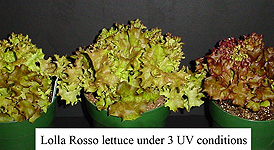This page has been archived and is being provided for reference purposes only. The page is no longer being updated, and therefore, links on the page may be invalid.
|
|
Lettuce Carotenoids Affected by UV Light in Greenhouse
By Rosalie Marion BlissFebruary 23, 2009
Growing the right type of green leaf lettuce during winter in a greenhouse—and exposing it to the right type of ultraviolet light—can boost levels of nutritionally beneficial carotenoids, according to an Agricultural Research Service (ARS) study.
Dietary carotenoids are biological antioxidants that protect cells and tissue from damage caused by naturally occurring oxygen free radicals in the body. Consistently eating carotenoids obtained from recommended servings of green leafy vegetables, along with a healthy diet, may help reduce the risk of cataracts and macular degeneration later in life.
The study was conducted by plant physiologists Charles Caldwell (retired) and Steven Britz with the ARS Beltsville Human Nutrition Research Center in Beltsville, Md.
In the field, plants express beneficial chemical compounds that are thought to be a means to protect themselves from the effects of UV radiation. Caldwell and Britz examined the role of light exposure and cultivar selection on the relative content of several of these compounds. They studied eight green and eight red leaf lettuce varieties, each receiving either supplemental ultraviolet-A (UV-A) light, both UV-A and ultraviolet-B (UV-B) light, or no UV (receiving only regular light).
Supplemental UV-A plus UV-B greatly increased the carotenoid and chlorophyll concentrations of the green leaf lettuce varieties, while slightly but significantly reducing the levels of those compounds in the red varieties. Interestingly, significantly higher levels of other phenolic phytochemicals were produced in the red leaf lettuce varieties, compared to the green leaf lettuce varieties under the same UV treatment conditions.
Among the green leaf lettuce varieties, under identical light and growing conditions, "Concept" had about 10 times the level of lutein, a carotenoid, as "Black-Seeded Simpson." Also, the amount of lutein in two green varieties—"Marin" and "Waldmann's Dark Green"—more than doubled after receiving both supplemental UV-A and UV-B light, when compared to lettuce that received only regular light.
These and other published findings from the study show selecting specific cultivars for commercial greenhouse production can result in lettuce with major differences in phytonutrient content.
ARS is the principal intramural scientific research agency of the U.S. Department of Agriculture.

